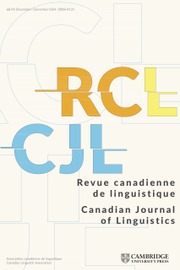Article contents
On Some Special Adverbs, Word Order, and CP: Variation vs.Micro-Variation
Published online by Cambridge University Press: 27 June 2016
Abstract
For some adverbs, European and Brazilian Portuguese sharply differ, withconsequences for the syntax of tense, quantification, word order, quantifierfloating, wh-extraction, and clause structure. Evidence is provided for thearchitecture of the left, for remnant IP movement, and for the claim that“micro-” lexical differences between European and BrazilianPortuguese reduce to syntactic “macro-” variation: absence vs.presence of V-movement.
Résumé
Par rapport à certains adverbes, le portugais d’Europe et duBrésil se différencient fortement, avec des conséquencespour la syntaxe du temps, la quantification, l’ordre des mots, ledéplacement des quanitifieurs, le déplacement-Qu et la structurede la phrase. Des données sont ici présentées qui portentsur l’architecture de la périphérie gauche, ledéplacement des IP résiduels et l’idée que lesdifférences « micro- » lexicales entre le portugaisd’Europe et du Brésil sont réductibles à la «macro- » variation syntaxique, à savoir l’absence versus laprésence du mouvement de V.
Information
- Type
- Articles
- Information
- Canadian Journal of Linguistics/Revue canadienne de linguistique , Volume 53 , Issue 2-3 , November 2008 , pp. 143 - 179
- Copyright
- Copyright © Canadian Linguistic Association/Association canadienne de linguistique 2008
References
- 4
- Cited by

